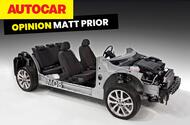More than 40 million cars on the MQB platform have been built – not all carrying a VW badge
There was a time when bosses at car manufacturers didn’t like to talk about platforms – the mechanical underpinnings of their cars.
These are expensive to develop, so big car companies share them across brands, and bosses used to think that it might be perceived as bad news if the public knew that a cheap car was largely the same underneath as an expensive one. So they preferred to keep schtum.
The really difficult and pricey bit to develop was – and still is, most notably in cars with engines – the area between the front wheels and the driver, because largely everything substantial goes into it.
There’s the engine itself, of course, plus the transmission, while behind it is the dashboard and everything that entails, including a whole heap of the electronics – more electronics than ever. Behind it is, put in very crude terms, something a car is just dragging around. So the same platform can host many different lengths of car.
That whole area is where the hard work goes. It has to be compact enough that a driver can see over the top of it. The structure around it has to be rigid enough to properly support the suspension and strong enough to support the forces flowing from the doors in a side impact. And yet it needs to be flexible enough to absorb frontal impacts without forcing the whole shebang into the passenger compartment.
More recently, it’s where loads of active safety and convenience equipment – sensors, cameras and more – have had to be mounted too.
Throwing in the fact that engines and gearboxes are now far more complex than ever means this part of a combustion-engined car is by some distance the most critical and expensive bit, so if a car maker can engineer it once and use it multiple times, so much the better.
Whatever decisions a manufacturer makes in this area therefore defines a raft of models. But thinking that customers wouldn’t necessarily appreciate knowing that, they didn’t always want to talk about it.
It turns out, though, that the car buying public doesn’t care that much at all if what lives beneath, say, their Audi is similar to what lives beneath their Skoda. I’ve heard people say “it’s basically a Volkswagen underneath†about a Skoda to convince themselves they’ve got a well-engineered budget car.
But I don’t think I’ve heard someone say the same about their Porsche Cayenne. They seem contented that Porsche has done extra work somewhere and that it was worth paying for.
And since it turns out that few people seem to care either way, in my experience car makers today seem less guarded about talking platforms and architectures than they used to be.
That has made it much easier to talk to designers and engineers about their cars. It has helped them to explain new models and helped us understand them. It has also (and it’s possible that they like this less) made it easier to quiz them about upcoming variants, particularly when it comes to sporty versions.
If we know a particular engine fits or can make a certain amount of power, or if we know a platform has been made to accommodate four-wheel drive, then surely, engineer, you could, you know, make a GTI/R/RS/etc, couldn’t you? Do tell us more.
Sometimes that has prompted a clear answer: “Sorry, mate, that platform can’t be four-wheel drive, and it would be too expensive to engineer it differently for just a few sporty cars, so there will be no really fast variant of that car.â€In the case of EVs, things aren’t quite so straightforward.
Four-wheel-drive EVs need only a motor at the back, not a driveshaft from the front. But if the rear suspension, a subframe or the body isn’t designed to accommodate one, it’s still an expensive re-engineering job.
Or rather it was. It turns out that this particular platform limitation might no longer apply. It’s suggested that the upcoming Volkswagen ID 2 R will have not only a powerful front motor but also a motor inside each rear wheel.
No room for a motor and a differential under the boot floor? No problem: in the hub it can go. I hadn’t thought about that before, but I think it basically means almost any platform could end up hosting any drive configuration that a manufacturer chooses.
The rules as we know them continue to shift.

